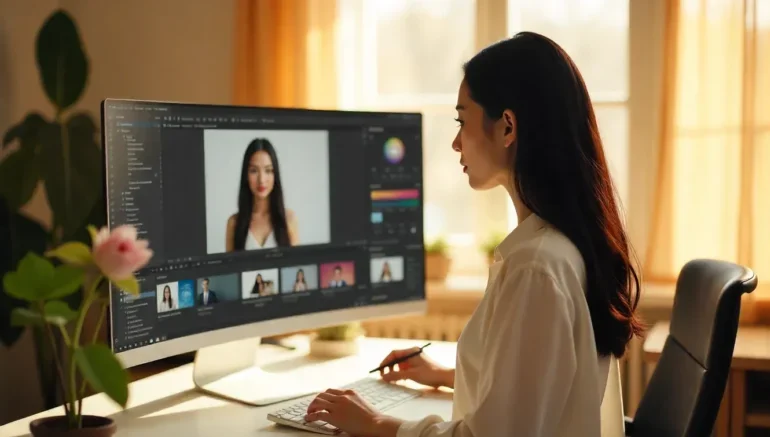
5 Key Things to Improve in Portrait Editing
Portrait photo editing is an art that deals with precision, creativity, and an eye for detail. A potentially great portrait goes from ordinary to great with the right technique. The rest of this article will explain 5 important elements to focus on in portrait photo editing that would ensure the image is stunning, captivating, and truly reflects the personality and beauty of your subject.
The Power of Portrait Editing
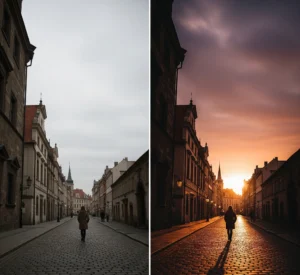 Portrait photo editing can be so much more than just changing brightness or contrast to taste. Portrait photo editing is an art of telling stories through the originality of emotion and capturing the real essence of the subject. At the beginning, when one starts the edition of a portrait photo, one has first of all to consider what kind of mood or atmosphere is desired throughout the photo. Is the portrait going to be warm and friendly, or does it need a cooler, more dramatic edge? This initial decision will guide your editing choices throughout the process.
Portrait photo editing can be so much more than just changing brightness or contrast to taste. Portrait photo editing is an art of telling stories through the originality of emotion and capturing the real essence of the subject. At the beginning, when one starts the edition of a portrait photo, one has first of all to consider what kind of mood or atmosphere is desired throughout the photo. Is the portrait going to be warm and friendly, or does it need a cooler, more dramatic edge? This initial decision will guide your editing choices throughout the process.
Next, pay attention to the facial expression and the body language of the subject. Is it relaxed and easy, or does he or she appear tense and ill at ease? These little things can make a huge difference in how you edit, since it may give you an idea of the subject’s true personality and mood.
Also, consider the purpose of this portrait. If it is some sort of special occasion or very casual, then that will determine how much detail and refinement you apply to the final editing phase.
Be sensitive with the tools and techniques you apply in portrait photo editing. You want to reach a balance over-editing can make a subject look unnatural while under-editing can be less interesting. Use adjustment layers, filters, and brushes together to reveal the beauty in the subject without distorting facial features into unrecognizable variables. The ultimate achievement you should make in the portrait is to reveal the subject as themselves, eloquently and honestly.
1. Enhancing Eyes in Portrait Editing
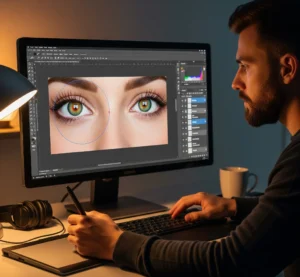 The eyes are two of the most important aspects in any portrait because they always stop a viewer and keep him looking at the picture. You might also consider eyes as part of portrait photo editing, adjusting their brightness, contrast, and color for an appealing effect. It is even possible to add some fine glow or highlight to make eyes more radiant.
The eyes are two of the most important aspects in any portrait because they always stop a viewer and keep him looking at the picture. You might also consider eyes as part of portrait photo editing, adjusting their brightness, contrast, and color for an appealing effect. It is even possible to add some fine glow or highlight to make eyes more radiant.
Do not bypass the area around the eyes, at least both eyelids and eyebrows. Use soft brushes to remove wrinkles and uneven parts, adding a bit of color for skin warmth. At the same time, though, be prudent not to overdo it, as aggressive smoothing will make the skin seem unnatural.
Everything is in nailing the eyes in this selfie and social media era. The right portrait photo editing will apply that sparkle to the eyes and give them personality and charm; this makes the portrait much more interesting and more like your subject.
2. Perfect Skin Tone in Portrait Editing
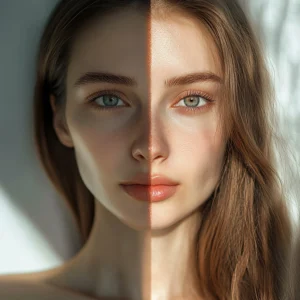 Skin tone boost during portrait photo editing is an art that one should delicately perform once they understand the undertones, warmth, coolness, and all that defines the natural complexion of their subject. While editing, start by closely observing the skin tone of the subject;. Use adjustment layers and curves to perfect the skin in terms of brightness, contrast, and saturation, not making it lose its original texture or warmth. This makes the portrait a bit more natural, though very attractive.
Skin tone boost during portrait photo editing is an art that one should delicately perform once they understand the undertones, warmth, coolness, and all that defines the natural complexion of their subject. While editing, start by closely observing the skin tone of the subject;. Use adjustment layers and curves to perfect the skin in terms of brightness, contrast, and saturation, not making it lose its original texture or warmth. This makes the portrait a bit more natural, though very attractive.
Besides the general skin tone, notice the structure of the face and bones. Employ soft brushes and portrait photography editing tools to improve the lines and contours of his/her features, adding depth and three-dimensional qualities to the photo. Subtlety, of course, is the watchword here, as too much retouching all too often leads to unnatural, exaggerated features that detract from the subject’s genuine likeness.
Success in skin tone upgrade is all about subtlety. Avoid too much editing, which might give an over-manipulated appearance. Instead, focus on making small improvements that could amplify your subject’s natural beauty and make them look radiant, confident, full of life. That’s how you manage to have a professional portrait with subtle changes which show the character of your model but still keeps it very natural.
3. Enhancing Natural Beauty
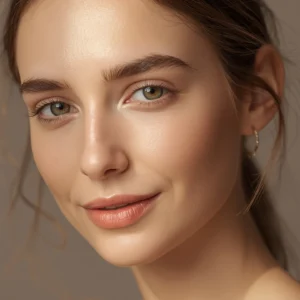 Fundamental in editing a portrait photo is to polish the beauty of the subject, not to change how he or she looks. What needs to be developed are, in fact, natural features that make each subject unique and special, and not alter them simply to fit an ideal or fashion. In this way, the portrait remains realistic and true to life.
Fundamental in editing a portrait photo is to polish the beauty of the subject, not to change how he or she looks. What needs to be developed are, in fact, natural features that make each subject unique and special, and not alter them simply to fit an ideal or fashion. In this way, the portrait remains realistic and true to life.
Start by observing the natural strengths of the subject’s appearance, skin tone, facial structure, and expression. Use portrait photo editing tools that will help you subtly refines those attributes, making sure adjustments honor and celebrate the subject’s natural features, refines clarity in their eyes, retouch slight skin imperfections, and adjust lighting so that it accentuates their best angles while still upholding their actual likeness.
Editing portrait photos effectively is a balancing act-between improvement and veracity. One needs to make refinements that strengthens the overall quality of the image without overriding the originality of the subject’s appearance or distorting it in some unwanted way. That would include avoiding excessive retouching and filter overuse, which might make the image look artificial or generic.
Portrait photo editing can take a picture of an individual to their best while it takes their characteristics. The result is a portrait that honors the true beauty of a subject by making him or her look one’s best while staying true to who he or she really is.
4. Adjusting Exposure in Portrait Editing
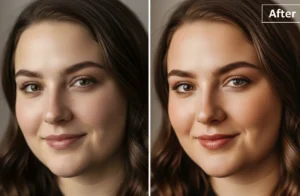 Begin by adjusting the photograph in respect of the general brightness and contrast. Further adjustments will be done to make the portrait even and special.
Begin by adjusting the photograph in respect of the general brightness and contrast. Further adjustments will be done to make the portrait even and special.
Emphasize some areas like the subject face and skin tone. Since some editing is needed to make brightness and contrast right, do not sacrifice the natural skin look and feel.
Now, consider the mood. If the portrait is to feel friendly and warm, softer contrast and warm tones create that effect. To create a more dramatic look in your portrait, adjust the contrast higher and lighten the light source to accentuate features and form shadows.
Experiment with different methods of improving the portrait. Delicate highlights can make the eyes pop, while forms of shadow can add depth. But be very cautious in doing so because subtlety works here.
Last but not least, you have to make sure that the edits fit the subject’s personality and the purpose of the portrait. The well-balanced exposure and contrast will make the portrait look natural and true to the subject.
5. Background and Context
 The background of a portrait is very important. In portrait photo editing, much can be done to make the difference in the picture. It should be one that does not obstruct the subject from being the central view; it should basically be one that blends in with the subject.
The background of a portrait is very important. In portrait photo editing, much can be done to make the difference in the picture. It should be one that does not obstruct the subject from being the central view; it should basically be one that blends in with the subject.
Ensure the background supports the subject. The background should contrast with the subject enough to help it stand out. The background can be blurred or adjusted using an editing tool so that it goes well with the subject. It would make the subject look much more stranded with a blurred background.
In background editing, use color and brightness adjustments of the background with tools so that it is not competing with the subject. You may also want to go for some blur effects or any other adjustment to fit the background with the look of your subject.
Consider the portrait’s intended usage. A professional photo should be taken against a plain background. You can use a more interesting background for personal or creative portraits, but it has to support the subject.
In short, good portrait photo editing involves making sure both the subject and background are great together. You’re going to want to adjust that background in a way that will make your subject pop and bring the image into balance.
Enhancing Portraits with Color Grading
Color grading will make your portrait photos look amazing. In portrait photo editing, color grading helps in adjusting the colors to give your photos that special and polished look.
First, check the overall color of your photo. Do corrections to make sure the colors just complement one another and look balanced.
Emphasize the subject’s face and skin color next. Perform the color grading of these areas by warming up the skin tone or adjusting colors to make the eyes pop.
Of course, you should avoid overdoing it-too much color grading will degrade the naturalness of the photo. Perform subtler adjustments to maintain the portrait with life-like vibrancy, close to the subject.
In the process, you will be able to take great pictures portraying the personality of the subject. Pay attention to eye details, skin tone, features of the face, and brightness and contrast in general. You will get better in Portrait Photo Editing and after every practice, you will have impressive photos.
Conclusion
In conclusion, Portrait photo editing is an art and science, both of which include precision, creativity, and a deep sense of the subject matter. The attention to detail, including eyes, skin tone, natural beauty, exposure, contrast, background, and color grading, can make any ordinary portrait extraordinary. Every aspect in editing plays an important role in amplifying the natural features of the subject and hence presents the real identity of the picture.
You’ll find balance in refinement and authenticity to create portraits that look great, yet still speak for the personality and story of the subject. That is, you will know how to be in control of portrait photo editing that makes images dazzling, yet true to reality. Your portraits will be more than just impressing the viewer; they will celebrate each individual’s unique beauty while making each photo a work of art.
Read next: 5 Photography Styles That Boost E-Commerce Sales





